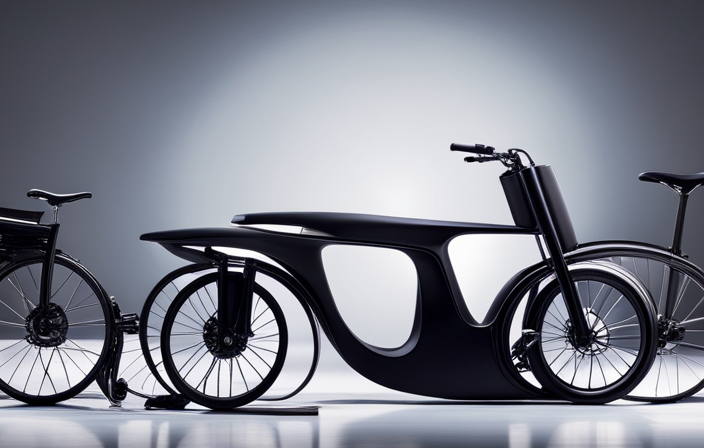Ever thought about the distinctions between a hybrid bike and an electric bike? In this article, we’ll delve into the main differences between these two popular types of bicycles.
From their basic components to their performance, cost, and environmental impact, we will delve into all aspects that make each bike unique.
By the end, you’ll have a clearer understanding of which bike is the right fit for you and your cycling needs.
Let’s dive in!
Key Takeaways
- Hybrid bikes combine features of road and mountain bikes, while electric bikes have a rechargeable battery that assists with pedaling.
- Electric bikes can reach speeds up to 20 mph and have multiple levels of pedal assist for steep hills, whereas hybrid bikes have a wide range of gears and are versatile on paved roads and gravel paths.
- Electric bikes have a higher upfront cost but offer long-term cost savings due to less maintenance, while hybrid bikes have a lower initial cost.
- Both hybrid and electric bikes reduce carbon emissions and promote green transportation, but electric bikes are more energy-efficient and can be charged using renewable energy sources.
Hybrid Bike Basics
A hybrid bike combines the features of a road bike and a mountain bike. It is designed to offer versatility and performance on various terrains. The hybrid bike design typically includes a lightweight frame, narrower tires than a mountain bike, and a more upright riding position compared to a road bike. This combination allows for a comfortable ride on both paved roads and gravel paths.
Hybrid bike components often include a suspension fork to absorb shocks, disc brakes for reliable stopping power, and a wide range of gears for tackling different types of terrain. Some hybrid bikes also come with fenders, racks, and lights for added convenience and visibility.
Now, let’s talk about electric bike basics, which offer an additional level of power assistance.
Electric Bike Basics
Electric bikes, also known as e-bikes, use a rechargeable battery to assist with pedaling. This battery-powered assistance makes riding an electric bike easier and less strenuous, especially when going uphill or against strong winds.
One of the advantages of electric bikes is that they provide an extra boost of power, allowing riders to travel at higher speeds without exerting as much effort. Additionally, e-bikes are more eco-friendly than hybrid bikes, as they produce zero emissions while riding.
On the other hand, hybrid bikes have their disadvantages when compared to electric bikes. Hybrid bikes rely solely on the rider’s pedaling power, which can be challenging for some, especially on steep terrains or during long rides.
Transitioning to the next section about performance and range, it’s important to consider how electric bikes excel in these areas.
Performance and Range
When it comes to performance and range, you’ll appreciate the capabilities and endurance of an electric bike. Electric bikes are equipped with advanced battery technology, allowing them to travel longer distances without running out of power. The range of an electric bike can vary depending on factors such as the motor power and the terrain you’re riding on.
Here are five key points to consider:
- Electric bikes can reach speeds of up to 20 mph, providing a quick and efficient mode of transportation.
- They offer multiple levels of pedal assist, allowing you to easily conquer steep hills and challenging terrains.
- The battery technology used in electric bikes has improved over the years, providing longer-lasting power.
- Some electric bikes have regenerative braking systems, which help recharge the battery while you ride.
- With the option to toggle between pedal-assist and full electric mode, you have control over the amount of effort you exert.
Considering the performance and range of electric bikes, it’s important to also evaluate their cost and affordability, which will be discussed in the next section.
Cost and Affordability
To determine if an electric bike is within your budget, you’ll want to consider the cost and affordability.
When comparing the cost of a hybrid bike and an electric bike, it’s important to take into account the initial purchase price as well as the long-term cost savings. Electric bikes generally have a higher upfront cost than hybrid bikes due to the advanced technology and components involved.
However, when it comes to maintenance costs, electric bikes often have an advantage. They require less maintenance than traditional bikes, as they have fewer moving parts and don’t require regular oil changes or tune-ups. This can result in long-term cost savings, as you won’t have to spend as much on repairs and maintenance.
Considering both the initial cost and long-term savings, electric bikes can be a more affordable option in the long run.
Moving on to the environmental impact…
Environmental Impact
When it comes to the environmental impact of electric bikes, there are several key points to consider.
Firstly, electric bikes contribute to the reduction of carbon emissions as they run on electricity instead of fossil fuels. This makes them a much greener transportation option compared to traditional bikes or cars.
Secondly, electric bikes are known for their energy efficiency, as they require much less energy to operate compared to other modes of transportation.
Lastly, electric bikes provide a sustainable transportation option, as they can be charged using renewable energy sources such as solar power.
Overall, electric bikes are a great choice for those looking to reduce their carbon footprint and contribute to a more sustainable future.
Reduction of Carbon Emissions
The reduction of carbon emissions is a major advantage of both hybrid and electric bikes. These bikes contribute to a cleaner environment by relying on renewable energy sources and promoting green transportation.
Here are three ways in which hybrid and electric bikes help in reducing carbon emissions:
-
Zero tailpipe emissions: Unlike conventional bikes, both hybrid and electric bikes produce zero tailpipe emissions, as they are powered by electricity instead of fossil fuels. This significantly reduces the amount of harmful greenhouse gases released into the atmosphere.
-
Energy-efficient operation: Hybrid and electric bikes are designed to be energy-efficient, utilizing power only when needed. This results in less energy waste and further reduces carbon emissions.
-
Promotion of sustainable practices: By choosing to ride hybrid or electric bikes, individuals contribute to a sustainable lifestyle and encourage others to adopt green transportation options. This collective effort plays a crucial role in reducing overall carbon emissions and combating climate change.
Considering their environmental benefits, it is clear that hybrid and electric bikes are effective tools in reducing carbon emissions and promoting a greener future.
Transitioning to the next section, let’s now explore their energy efficiency.
Energy Efficiency
Hybrid and electric bikes are designed to operate efficiently and maximize energy usage. When it comes to energy consumption, electric bikes are generally more efficient than hybrid bikes.
Electric bikes use a battery-powered motor to assist the rider, allowing for less effort and energy exertion. This means that riders can go longer distances without feeling fatigued.
On the other hand, hybrid bikes rely on a combination of human power and electric assistance, which can lead to a higher energy consumption compared to electric bikes.
Additionally, battery life is a crucial factor to consider. Electric bikes typically have a longer battery life compared to hybrid bikes, allowing riders to travel farther without needing to recharge.
This makes electric bikes a sustainable transportation option for those looking to reduce their carbon footprint and enjoy an energy-efficient ride.
Sustainable Transportation Option
As we discussed earlier, energy efficiency is an important factor when comparing hybrid and electric bikes. Now, let’s delve into another crucial aspect of these bikes: their role in sustainable transportation. As a cyclist myself, I am always on the lookout for green transportation options that minimize my carbon footprint. Both hybrid and electric bikes offer a fantastic alternative for commuting, allowing riders to contribute to a cleaner and healthier environment. By opting for these bikes instead of traditional vehicles, we can reduce air pollution and decrease our dependence on fossil fuels. To illustrate the environmental benefits, consider the following table:
| Hybrid Bike | Electric Bike |
|---|---|
| Low emissions | Zero emissions |
| Pedal-assist technology | Fully electric |
| Limited range | Longer range |
With these sustainable options, we can make a positive impact on our planet. Now, let’s explore the riding experience and comfort these bikes provide.
Riding Experience and Comfort
When it comes to riding experience and comfort, there are several key points to consider.
First, the ease of use is important, as you want a bike that is user-friendly and doesn’t require a steep learning curve.
Second, handling and control play a critical role in ensuring a smooth and enjoyable ride, so it’s crucial to find a bike that offers responsive and precise handling.
Lastly, ride quality and suspension are essential for comfort, especially when riding on rough or uneven surfaces, so opting for a bike with good suspension can greatly enhance your overall riding experience.
Ease of Use
To make it easier for you, an electric bike is more user-friendly than a hybrid bike. When it comes to ease of use, electric bikes have a clear advantage. One of the main reasons is the ease of maintenance. Electric bikes require less maintenance compared to hybrid bikes. With no combustion engine, there are fewer parts that can break or wear out. Additionally, the battery life of electric bikes has improved significantly in recent years. Most electric bikes can now cover long distances before needing to be recharged. This eliminates the worry of running out of power during your ride.
Now, let’s move on to the next section about handling and control, where we’ll discuss another important aspect of these bikes.
Handling and Control
You’ll notice a significant contrast in the way you handle and control the two types of bikes. Here are four key differences:
-
Steering control: Electric bikes tend to have a more responsive and precise steering control compared to hybrid bikes. This allows for easier maneuverability, especially in tight spaces.
-
Stability: Hybrid bikes generally offer better stability due to their heavier frames and lower center of gravity. This can make them more suitable for riders who prioritize a stable and secure ride.
-
Braking performance: Electric bikes often have superior braking performance, thanks to their regenerative braking systems. This allows for quicker and more efficient stopping power.
-
Acceleration speed and power delivery: Electric bikes excel in terms of acceleration speed and power delivery. The instant torque from the electric motor gives them a quick and powerful boost, making them ideal for fast-paced rides.
Considering these factors, it’s important to note that ride quality and suspension also play a crucial role in the overall biking experience.
Ride Quality and Suspension
The ride quality and suspension of each type of bike greatly impact the overall biking experience. When it comes to ride smoothness, both hybrid and electric bikes have their own advantages. Hybrid bikes generally offer a smoother ride due to their suspension technology. They are equipped with front suspension forks that absorb bumps and shocks on the road, providing a more comfortable and enjoyable ride. On the other hand, electric bikes may not have the same level of suspension as hybrid bikes, but they compensate for it with their electric motor assistance, which helps to reduce the impact of uneven terrain. Overall, the ride quality of both types of bikes can be enhanced with the use of appropriate suspension technology. Moving on to the next section about fitness and exercise benefits, riding these bikes can provide a great workout while being gentle on the joints.
Fitness and Exercise Benefits
One of the benefits of a hybrid or electric bike is that it can improve your fitness and help you exercise. These bikes provide an excellent way to work on your cardiovascular health. Riding them regularly can increase your heart rate, improve blood circulation, and enhance lung capacity.
Additionally, pedaling an electric bike can also contribute to increased muscle strength. The resistance offered by pedaling against the motor’s assistance helps to tone and strengthen your leg muscles. Moreover, these bikes allow riders to choose their level of assistance, meaning you can gradually increase the effort required to pedal, providing a challenging workout as your fitness improves.
Moving on to the next section about ‘practicality and versatility,’ it’s worth considering the various benefits these bikes offer beyond fitness alone.
Practicality and Versatility
When considering the practicality and versatility of a hybrid or electric bike, there are several key points to discuss.
Firstly, these bikes are excellent for commuting and urban riding. They allow me to navigate through traffic and reach my destination quickly and efficiently.
Secondly, the cargo and storage capacity of these bikes is impressive. I can attach baskets or panniers to carry groceries or other items.
Lastly, the adaptability of these bikes to different terrains is a major advantage. They can handle both paved roads and off-road trails with ease.
Overall, these features make hybrid and electric bikes highly practical and versatile options for various types of riders.
Commuting and Urban Riding
For commuting and urban riding, a hybrid bike is a great option because it combines the benefits of an electric bike and a traditional bike. Here are four reasons why a hybrid bike is ideal for these types of rides:
-
Bike safety: Hybrid bikes are equipped with features such as lights, reflectors, and bells, which enhance visibility and ensure a safer ride in busy urban areas.
-
Choosing the right gear: Hybrid bikes offer a wide range of gears, allowing riders to easily navigate different terrains and adjust their speed according to traffic conditions.
-
Maneuverability: With their lightweight frames and agile design, hybrid bikes are perfect for weaving through city streets and maneuvering in tight spaces.
-
Efficiency: Hybrid bikes provide the option to pedal manually or use electric assistance, making them suitable for both longer commutes and shorter trips around town.
When it comes to cargo and storage capacity, hybrid bikes also have some impressive features that make them a practical choice.
Cargo and Storage Capacity
Hybrid bikes offer convenient cargo and storage capacity options, making them a practical choice for transporting belongings while riding in urban areas. With their sturdy frames and additional attachments, hybrid bikes can handle various cargo loads, from groceries to work equipment. Most hybrid bikes come with rear racks or baskets, allowing riders to easily secure their belongings. Additionally, some models offer front racks or pannier bags for even more storage options. This versatility is especially beneficial for commuters who need to carry laptops, gym clothes, or other essentials. Hybrid bikes also often have built-in fender and mudguard systems, ensuring that cargo stays protected from rain and debris. With their ample cargo and storage capacity, hybrid bikes are well-suited for urban riders who value practicality and convenience.
Transitioning to the subsequent section about adaptability to different terrains, hybrid bikes also excel in providing a smooth and comfortable ride on various surfaces.
Adaptability to Different Terrains
With their versatile design, hybrid bikes can easily handle a variety of terrains. Their adaptability to different terrains is one of the key features that sets them apart from electric bikes.
Hybrid bikes are equipped with suspension options that allow for a smoother ride, even on rough or uneven surfaces. This is especially beneficial when riding on gravel paths, dirt trails, or bumpy roads. The suspension helps to absorb shocks and vibrations, providing a more comfortable and stable experience.
Whether you’re navigating through city streets or exploring off-road trails, a hybrid bike offers the flexibility to handle different terrains with ease. Considerations for choosing the right bike include factors such as your riding preferences, terrain types, and overall comfort.
Considerations for Choosing the Right Bike
When deciding on the right bike, it’s important to consider various factors. Here are some key considerations to keep in mind:
-
Bike weight: One important factor to consider is the weight of the bike. Electric bikes are generally heavier than hybrid bikes due to the additional weight of the battery. This can affect maneuverability and ease of handling, especially if you plan on riding in hilly areas or need to carry the bike up stairs.
-
Maintenance costs: Another factor to consider is the maintenance costs associated with each type of bike. Electric bikes may require more maintenance due to the electrical components, such as the battery and motor. It’s important to factor in the cost of battery replacements and repairs when considering the overall cost of owning an electric bike.
Considering these factors will help you make an informed decision based on your specific needs and preferences.
In conclusion, understanding the differences between hybrid and electric bikes, including their adaptability to different terrains and other considerations, is crucial in choosing the right bike for you.
Conclusion and Final Thoughts
In summary, considering all the factors outlined earlier can help you make an informed decision and choose the perfect bike for your specific needs and preferences.
When it comes to cost effectiveness and overall value, both hybrid and electric bikes have their advantages. Hybrid bikes are generally more affordable upfront and require less maintenance compared to electric bikes. They are a great option for those who want a bike that is versatile and can handle different terrains.
On the other hand, electric bikes offer the convenience of motor assistance, making it easier to tackle hills and long distances. While electric bikes may have a higher initial cost, they can save you money in the long run by reducing the need for car transportation and decreasing fuel expenses.
Ultimately, the choice between a hybrid and an electric bike depends on your budget, intended use, and personal preferences.
Frequently Asked Questions
Can I use a hybrid bike for off-road trails and rugged terrains?
Yes, you can use a hybrid bike for off-road trails and rugged terrains. It provides a versatile ride with a mix of features from mountain and road bikes, making it suitable for city commuting as well.
How long does it typically take to charge an electric bike’s battery?
Charging an electric bike’s battery typically takes a few hours, depending on the battery size and charger used. It’s important to note that frequent charging and discharging can affect the battery lifespan.
Are there any government incentives or tax credits available for purchasing a hybrid or electric bike?
Yes, there are government incentives and tax credits available for purchasing a hybrid or electric bike. These incentives vary by location and can include tax deductions, rebates, or grants to help offset the cost of the bike.
Can I convert my regular bicycle into a hybrid or electric bike?
Yes, it is possible to convert a regular bicycle into a hybrid or electric bike. However, there are pros and cons to consider. Hybrid bikes offer a combination of pedal power and electric assistance, while electric bikes provide full electric propulsion.
Are there any maintenance or servicing requirements specific to hybrid or electric bikes that I should know about?
Maintenance requirements for hybrid and electric bikes are important to keep in mind. Regularly check the battery, motor, and wiring for any issues. Common problems include battery degradation, motor malfunctions, and electrical system failures.
Conclusion
After exploring the differences between hybrid and electric bikes, it’s clear that both have their unique advantages.
Hybrid bikes offer the flexibility of pedaling and the option to switch to electric assistance. This means you can choose to put in some physical effort or let the motor do the work when you need a break. It’s like having the best of both worlds.
On the other hand, electric bikes provide a fully motorized experience. With an electric bike, you don’t have to pedal at all if you don’t want to. The motor takes care of all the hard work, making it a great option for those who want a more effortless ride.
Choosing between the two ultimately depends on your specific needs and preferences. It’s like deciding between a versatile Swiss army knife and a powerful sports car. Both have their merits, but it’s up to you to decide which one suits your lifestyle and goals better.
So, whether you’re looking for a bike that gives you the option to switch between pedaling and electric assistance or one that provides a completely motorized experience, there’s a bike out there for you. Happy cycling!
















